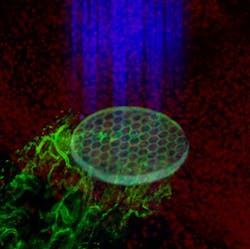Open-source technology enables closed-loop optogenetics
Researchers at the Georgia Institute of Technology (Georgia Tech; Atlanta, GA) have created an open-source technology that allows for closed-loop optogenetics. The technique uses a computer to acquire and process the neuronal response to the optical stimulus in real time and then vary the light input to maintain a desired firing rate. By providing this feedback control, the technology—dubbed optoclamp—could facilitate research into new therapies for epilepsy, Parkinson’s disease, chronic pain, and depression.
Optogenetics provides a powerful tool for studying the brain by allowing researchers to activate neurons using simple light-based signals. But until now, these optical stimulation techniques have been open-loop, meaning they lack the kind of feedback control that most biological and engineering systems use to maintain a steady operating state.
Optogenetics technology places genes that express light-sensitive proteins into mammalian cells that normally lack such proteins. When the proteins are illuminated with specific wavelengths of light, they change the behavior of the cells, introducing certain types of ions or pushing ions out of the cells to alter electrical activity. But without a feedback loop, scientists could only assume that the optical signals were having the effects desired—or try to confirm at the end of the experiment that this had happened.
“Our work establishes a versatile test bed for creating the responsive neurotherapeutic tools of the future,” says Steve Potter, an associate professor in the Wallace H. Coulter Department of Biomedical Engineering at Georgia Tech and Emory University. “Neural modulation therapies of the future, whether they be targeted drug delivery, electrical stimulation, or even light-plus-optogenetics through fiber optics, will all be closed-loop. That means they will be responsive to the moment-to-moment needs of the nervous system.”
Optoclamp provides continuous, real-time adjustments of optical stimulation to lock neural spiking activity to specified targets over time scales ranging from seconds to days. By providing precise optical control of firing in neuronal populations, the technology will help scientists disentangle causally related variables of circuit activation.
Researchers in Potter's lab studied the effects of open-loop optical stimulation on neural systems, and found considerable variation in the responses of neuronal networks grown on multi-electrode arrays and in the neurons of animal models.
“The same stimulus pattern can produce highly variable levels of activity,” said Jon Newman, who built the optoclamp while a PhD student in Georgia Tech’s Laboratory for Neuroengineering. Newman is now a postdoctoral researcher at MIT. “The amount of optical stimulation needed to achieve the same level of activity varied by orders of magnitude, depending on the population that was being controlled, or even in the same type of cells and preparation, but within different subjects.”
In a cultured cortical network, the optoclamp records activity from as many as 200 cells, using them to measure activity in the larger culture population, which can include as many as a million cells.
“Because we have all those electrodes, we can process the data in real time and then compare the amount of activity being expressed by the culture to a target rate, then use the difference between those two signals to inform our optical stimulator to vary the intensities of different wavelengths of light,” Newman explained.
The optoclamp can be used to control cell cultures grown atop electrode arrays, as well as in living animal models in which electrodes have been implanted.
In research conducted with colleagues at Emory University (also in Atlanta), the optoclamp’s ability to maintain a steady neural firing state allowed researchers to study a key control issue in homeostatic plasticity, a phenomenon that results from a lack of neural stimulation. Scientists had believed that the effect was controlled by the firing rate of cells, but the optoclamp allowed the team of researchers to clamp firing at normal levels during the addition of a drug that inhibits neurotransmission. This showed that neurotransmission levels, not firing activity, governed a key form of homeostatic plasticity. Potential applications include chronic pain, epilepsy, tinnitus, phantom limb syndrome, and other nervous systems disorders where the brain has over-reacted to the loss of normal inputs.
Scientists are already using the optoclamp in its current form, but the researchers hope to improve spatial differentiation of the optical signals, allowing experiments to focus stimulation on specific areas of the brain or brain cell cultures. The light signals now affect an entire culture or brain region.
Full details of the work appear in the journal eLife; for more information, please visit http://dx.doi.org/10.7554/eLife.07192.
Follow us on Twitter, 'like' us on Facebook, connect with us on Google+, and join our group on LinkedIn


